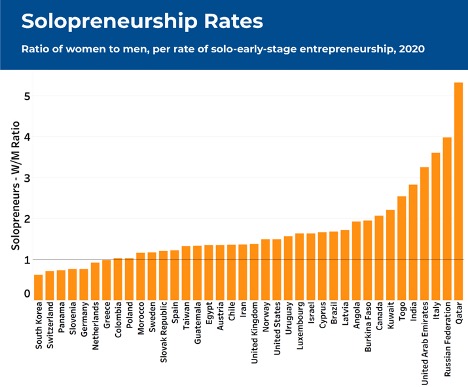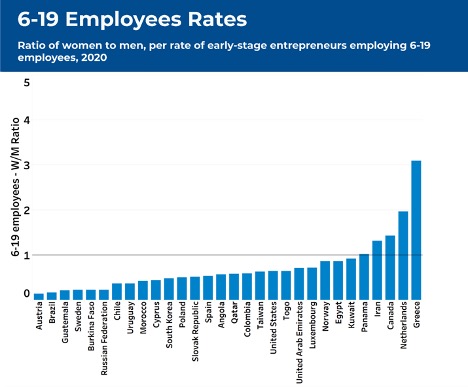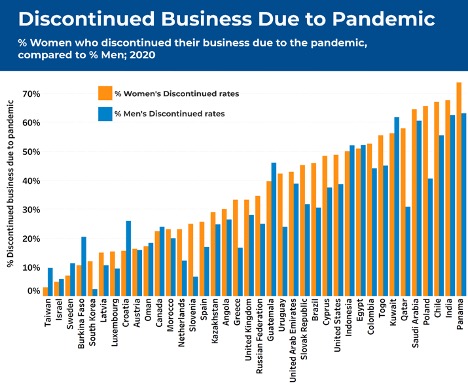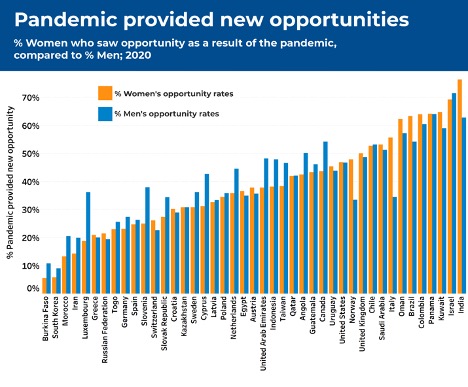By Forrest Wright, Aileen Ionescu-Somers, and Amanda Elam
Good news to highlight on #InternationalWomensDay: women’s participation in entrepreneurship has increased globally over the last several years. However, despite this overall progress, it still trails men’s entrepeneurship rates in many parts of the world. This is among the key findings of the Global Entrepreneurship Monitor 2020/2021 Women’s Entrepreneurship Report published in November 2021. A key point of differentiation from other entrepreneurship surveys is that GEM is the only global research source that collects data on business startup activity directly from individual entrepreneurs.
The report is based on surveys conducted in 43 countries. Below are some key findings, documenting both some points of optimism, as well as areas where more progress could be made.
The size of entrepeneurial ventures
High-potential women-led businesses are poised to drive innovation, economic growth, and job creation in countries around the globe. However, gender parity goals are stymied by the smaller size and market focus of women-led businesses and the negative stereotypes perpetuated by these sorts of aggregate trends.
In almost all participating GEM economies in 2020, women far exceeded men on the rate of solo entrepeneurship (solopreneurship) among both startups and older, established businesses. A solopreneur is someone who does not employ anyone in their business besides themselves.
Solopreneurship can offer a positive economic opportunity for anyone who prefers to work independently, or prefers (or needs) a more flexible work arrangement than a traditional job. It can also be an opportunity to gain additional income while working for someone else. In many cases, women start businesses without employees to achieve independence and flexibility, while at the same time gaining extra income.
However, this is not the full picture. Higher rates of women solopreneurship in most GEM economies can also signal a lack of opportunity or less attractive employment alternatives. Inability to access finance at the same rate as men, or a lack of family support, can hinder women’s ability to employ workers, even if they wanted to during the startup phase.
Below is the chart of participating GEM economies that collected data on solopreneurship by gender in 2020. A solopreneurship ratio of 1 indicates parity between women’s and men’s rates of solo early-stage entrepeneurial activity. So, as illustrated, in most GEM economies, women had significantly higher rates of solopreneurship in most, if not all, economies in the GEM 2020 survey.

One of the most important and promising findings in the Women’s Entrepreneurship Report is the high rate of growth aspirations among women entrepreneurs. In mid-2020, 30.2% women entrepreneurs surveyed expected to hire 6 or more employees in the next 5 years. By way of comparison, this figure was at 18.7% in the 2019 report.
While this is an encouraging trend towards greater numbers of high-potential women-led businesses, women continue to trail the 48% of men with high expectations for growth. In fact, male entrepreneurs are more likely to start and grow employer firms in most economies around the globe. Below are the gender ratios of early-stage businesses with 6-19 employees for participating GEM economies.

In this case, the majority of GEM economies had ratios under 1, indicating that far fewer women entrepreneurs had 6-19 employees than men. In several countries, including Panama, Iran, Canada, the Netherlands and Greece, women’s early-stage businesses employing 6-19 workers outnumbered men’s.
COVID-19 Impact
The GEM 2020 survey provides a first look at gender differences in covid-19 impacts on business startup activity. Data was collected between April and August 2020 when many countries were experiencing first wave impacts, while others had yet to experience any disease spread.
The experience of women entrepreneurs during COVID-19 presents a mixed picture, with both negative and positive results that will require further study in the coming years. Women were more likely than men to report business closures due to COVID-19 impacts in most participating 2020 GEM economies. This gender difference has been attributed to both inequitable family arrangements – where women tend to take on the lion’s share of childcare and other family responsibilities - and the disproportionate impact on industry sectors where women tend to create more businesses and where businesses tend to be of smaller size.
Importantly, the largest gender gap was reported in North America and Europe, where women were 50% more likely than men to report closing a business due to the pandemic. Paradoxically, the trend was reversed in Central and East Asia where men were slightly more likely to report business closure due to the pandemic than women (37.7% vs 34%). Below are the rates of women’s early-stage entrepreneurial activity that had to be discontinued, compared to men’s for each 2020 participating GEM economy:

Despite evidence of heavier pandemic impacts in many GEM economies, entrepreneurial women reported seeing new business opportunities as a result of the COVID-19 pandemic at higher rates than men. This is highly encouraging as the pandemic has changed the state of business in many economies, so spotting opportunities may help more women improve their situation through entrepreneurship. Many international organizations and think-tanks have pointed to the pandemic as a “game-changer”. Could we be witnessing a major shift in the nature of women’s entrepreneurship? Only time will tell; future GEM studies will reveal whether this may be the case.

Because the COVID-19 pandemic impacts on entrepreneurship are still being felt in all economies, further study on multiple dimensions will be required. GEM will be publishing a Women’s Entrepreneurship Report annually, so we look forward to sharing future findings.
Tens of millions of women around the world are making an enormous impact through business startup and growth, in spite of persistent cultural and structural barriers limiting their growth opportunities. Now is the time to focus on how we can better support women entrepreneurs and business owners to more effectively scale their high-growth companies. Given these results, it behooves policymakers to consider how they could improve financing opportunities, family support policies, and mitigate potential gender bias to enable more parity between genders when it comes to starting and growing high-potential ventures.
In close, GEM findings underscore how public policies in many countries throughout the pandemic have fallen short in providing sufficient support for family care, schooling, small business relief, and industry-specific impacts, thus undermining potential progress for women entrepreneurs particularly for high-potential small businesses. Despite this, GEM research shows that women entrepreneurs have shown remarkable resilience and ingenuity in retaining their businesses, but also adapting to the resulting business disruptions and new market realities. We applaud their efforts.
Forrest Wright is the Data Manager for Global Entrepreneurship Monitor. Aileen Ionescu-Somers is Executive Director of Global Entrepreneurship Monitor. The full 2020/2021 Women’s Entrepreneurship Report can be accessed at this link. The lead author of the report is Amanda Elam, a GEM researcher and a Research Fellow at Babson College’s Diana International Research Institute.

